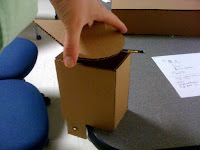Here is the We.bot! Enjoy.
Monday, November 9, 2009
Tuesday, November 3, 2009
Continuous Servo Motor with ARDUINO
The continuous servo motor is a little tricky to interface with the ARDUINO. The main challenge is to find out how to stop the rotation. Once called using myservo.write(value) it will continue to rotate at a certain speed.
Essentials:
-------------
1> The stop value for the continuous servo is generally around 90. However, it will not be exact. It could be 89, 92 etc. This needs to be determined by trial and error. This can also be adjusted by turning a small '+' on the motor. Once you determine this stop_value, please make a note of it on the motor.
2> One the above stop_value is determined, stop_value + (small_value) will rotate clockwise and stop_value - (small_value) will rotate anticlockwise or vice-versa and the speed is determined by how much you add or subtract to the stop_value. The final value should be in the range 0-180.
Regards
Vidya
Essentials:
-------------
1> The stop value for the continuous servo is generally around 90. However, it will not be exact. It could be 89, 92 etc. This needs to be determined by trial and error. This can also be adjusted by turning a small '+' on the motor. Once you determine this stop_value, please make a note of it on the motor.
2> One the above stop_value is determined, stop_value + (small_value) will rotate clockwise and stop_value - (small_value) will rotate anticlockwise or vice-versa and the speed is determined by how much you add or subtract to the stop_value. The final value should be in the range 0-180.
Regards
Vidya
Saturday, October 17, 2009
Thursday, October 15, 2009
Sunday, October 11, 2009
Saturday, October 10, 2009
Project 3 Teams
Akshay & Joe / Linnea - Room Scale
Raghu & Vidya - Component Scale (drawer)
Sumod & Tony - Object Scale (night stand)
Friday, October 9, 2009
Wednesday, September 30, 2009
Project 2 Teams
Tuesday, September 15, 2009
Monday, September 14, 2009
Wednesday, September 9, 2009
Tuesday, September 8, 2009
Friday, September 4, 2009
Project 1 - Development
Here are some sketches (via Raghu) of our projecte development. The project is due Sept 9 and we will have a youtube video plus our documents for review / critique.
Proposal Project 1
Here are some images of our first proposal (as a group) for the responsive architecture wall in a disco. The idea is that a sensor (in our case camera/face detection) will sense someone is there and move out a seat / table for the people dependent on the number of people. ie - 1 person a seat, 2 people a seating area, 3 people a bench, 4 people on a table for drinks. Comments welcome.
Inter Arduino communication
This is a good place to learn about inter-arduino communications.
http://absences.sofianaudry.com/en/node/10
I2C BUS : Stands for Inter Integrated Circuit. It basically is a protocol for communication between different embedded devices and sensors.. Like accelerometers, temp sensors, embedded controllers etc...
In case of arduinos, just hook up all the Analog 4th pins together and 5th pins together. Use a pull-up resistor of 1-2Kohm between +5V and these pins. Also if you are using different power sources, do remember to share them. That is to connect all the +5 together and GND's together. Careful not to short them.
In case of Arduino's we make use of the wire library, to make the I2C communications easy. Thats all... :)
http://absences.sofianaudry.com/en/node/10
I2C BUS : Stands for Inter Integrated Circuit. It basically is a protocol for communication between different embedded devices and sensors.. Like accelerometers, temp sensors, embedded controllers etc...
In case of arduinos, just hook up all the Analog 4th pins together and 5th pins together. Use a pull-up resistor of 1-2Kohm between +5V and these pins. Also if you are using different power sources, do remember to share them. That is to connect all the +5 together and GND's together. Careful not to short them.
In case of Arduino's we make use of the wire library, to make the I2C communications easy. Thats all... :)
Subscribe to:
Comments (Atom)








.jpg)
.jpg)
.jpg)



